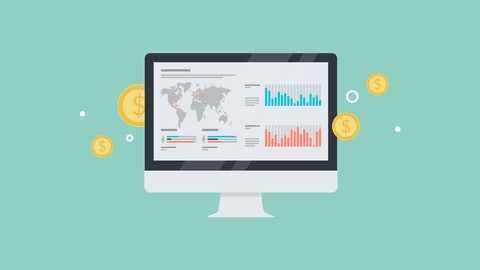The Complete Investment Banking Course 2024
Loại khoá học: Finance
The #1 Course to Land a Job in Investment Banking. IPOs, Bonds, M&A, Trading, LBOs, Valuation: Everything is included!
Mô tả
** Updated for November 2023 **
The Complete Investment Banking Course 2023 is the most hands-on, interactive and dynamic investment banking course you will find online.
+ 64 Pages of Course Notes
+ 12 Course Challenges
+ 26 PDF Files
+ 22 Quiz Questions
+ 32 Excel files
+ A complete Glossary with key terms and phrases
+ Real-world examples and case studies
+ Interesting facts about the industry
+ 2 Valuation models built from scratch
+ 11 hours of Full-HD video
The course starts off by introducing you to the four main areas of investment banking – Capital Markets, Advisory, Trading and Brokerage, and Asset Management.
Then we continue by digging deeper into each line of business.
You will learn the subtleties of Initial Public Offerings, Seasoned Equity Offerings, Private Placements, Bond Issuances, Loan Syndications, Securitizations, Mergers & Acquisitions, Restructurings, Trading Instruments, Asset Management Vehicles and more.
Pretty much everything that can come up in an investment banking interview.
However, the best part is that you will learn different valuation techniques like the ones used by Goldman Sachs, Morgan Stanley and J.P. Morgan. We will show you how to carry out a Discounted Cash Flow valuation, a multiples valuation, and an LBO valuation. You will learn how to estimate a company’s cost of capital and future cash flows. Don’t worry if these sound unfamiliar right now; everything is shown in the course - step-by-step - with no steps skipped.
This is a one-stop-shop, providing everything you need to land a job on Wall Street.
What makes this course different from the rest of the Finance courses out there?
High quality of production: Full-HD video and animations (This isn’t a collection of boring lectures!)
Knowledgeable instructor (1.5 million students on Udemy; worked in M&A)
Complete training: We will cover all major topics and skills you need to land a job in investment banking
Extensive Case Studies: To help you reinforce everything you’ve learned
An abundance of materials: PDF & Excel files, Infographics, Course notes; you name it! Everything is inside!
Excellent support: If you don’t understand a concept or you simply want to drop us a line, you’ll receive an answer within 1 business day
Dynamic: We don’t want to waste your time! The instructor keeps up a very good pace throughout the whole course
Bonus prizes: Upon completion of 50% and then 100% of the course, you will receive two bonus gifts
Why should you consider a career as an Investment Banker?
Salary. Investment Bankers are some of the best paid professionals in our society
Promotions. Investment Bankers acquire valuable technical skills, which makes them the leading candidates for senior roles in industrial companies and Private Equity firms
Growth. This isn’t a boring job. Every day you will face different challenges that will test your existing skills
Please don’t forget that the course comes with Udemy’s 30-day unconditional money-back-in-full guarantee. And why not give such a guarantee, when we are convinced that the course will provide a ton of value for you?
Just go ahead and subscribe to this course! If you don't acquire these skills now, you will miss an opportunity to separate yourself from the others. Don't risk your future success! Let's start learning together now!
Bạn sẽ học được gì
Start a career in Investment Banking or Private Equity
Pass investment banking interviews
Build financial models from scratch (shown step-by-step)
Build valuation models – DCF, LBO and multiples
Have solid financial and business acumen
Take your career to the next level!
Tell the story of how investment banking services first appeared
Understand the difference between investment and commercial banking
Explain the mechanics of an Initial Public Offering
Understand how pricing is determined in an IPO
Draw an IPO timetable
Understand why companies go public
Explain the mechanics of a bond offering
Understand how pricing is determined in a bond offering
Draw a bond offering timetable
Understand why companies raise public debt
Explain loan syndication and who participates in the syndicate
Understand securitization and explain why banks use securitization
Learn why companies buy other companies
Identify successful M&A transactions
Explain the deal lifecycle
Tell the difference between Financial and Corporate buyers
Describe the different payment options in an M&A deal
Understand the essence of restructuring services
Learn about the different ways to restructure a company
Become familiar with trading and brokerage and the securities traded on Financial Markets
Understand asset management services
Be able to describe asset management vehicles and expected rates of return
Calculate a company’s cost of debt, cost of equity, and WACC
Perform LBO valuation
Understand the rationale behind Leveraged Buyout deals
Be able to tell who carries out LBO deals and why they can be very profitable
After this course, you will have the skills to start a successful career in Investment Banking and Corporate Finance
Yêu cầu
- Absolutely no experience is required. We will start with the basics and gradually build up your knowledge. Everything is in the course.
- A willingness to learn and practice
Nội dung khoá học
Viết Bình Luận
Khoá học liên quan

Đăng ký get khoá học Udemy - Unica - Gitiho giá chỉ 50k!
Get khoá học giá rẻ ngay trước khi bị fix.


















Đánh giá của học viên
Bình luận khách hàng